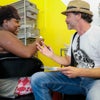The recent publication of "America's Youngest Outcasts" by the National Center on Family Homelessness reports a staggering 2.5 million homeless children under the age of 18. Justifiably, this news has people in an uproar.
As someone who has conducted extensive research with homeless teens and young adults for more than a decade, I am glad to see the problem making headlines and spurring discussion.
This report rightly focuses on homeless children in the context of families who have been hit by recent economic downturns, emphasizing the adverse effects to our most vulnerable. It also presents the opportunity to bring to light a group of youth who are not talked about nearly as much. Unaccompanied homeless youth -- usually between the ages of 13 and 24 -- are young people not in the physical custody of a parent or guardian who lack safe, stable housing.
Just how many are there? And why are they on America's streets?
Unfortunately, we really don't know. Homeless youth are difficult to count because their living situations are constantly changing, and most are not enrolled in our public school systems. Still others don't identify as homeless. At best, calculations estimate that nearly 2 million unaccompanied youth experience homelessness every year, but this is only a guess.
An important part of why we have such a poor understanding of the scope of youth homelessness is because these youth are so good at hiding in plain sight. Unlike homeless adults who often push shopping carts or sleep in shop doorways, most homeless youth walk down the streets and suburbs of America largely unnoticed. Adult homelessness becomes so obvious because of the accompanying severe mental illness and debilitating substance abuse problems that often plague its victims. But that's not the case with youth.
Sure, some homeless youth are recognizable, sitting on a corner with a cardboard sign, begging for spare change. But in my experience, the vast majority of the homeless youth I have known and worked with look like any other teen or young adult walking down the street, albeit their shoes might be a little more worn, and their backpacks might be a little overstuffed. And, frankly, if I didn't know them personally from the drop-in center or shelter in the neighborhood, they would be hidden from me, too.
So why are these youth homeless?
A few years ago, a young woman told me the tragic story of her middle class parents throwing her out of her home after they discovered a love note she had hidden in her bedroom. She was 17 at the time. The love note was written in girly script and proclaimed her love for her 16-year-old girlfriend.
Another young man told me about being placed in the foster care system so young that he doesn't remember his parents. Sadly, he was moved from group home to group home, where he never felt the love and security he needed, so he frequently ran away. I met up with him a few years later at My Friend's Place, an agency that serves 1,700 homeless youth each year in Hollywood.
Another young youth I worked with probably should have been in the foster care system. He told me about running away from home at age 15 to escape the violence his stepfather was directing both at him, his mother and his sister.
Unfortunately, these stories are all too common.
As a researcher, I have an opportunity to try to contextualize these stories. I just finished collecting more than 1,000 interviews with homeless youth in Los Angeles as part of a grant funded by the National Institute of Mental Health. Our findings are eye-opening. 42 percent of the youth we interviewed had been a part of the foster care system, and 27 percent were gay, lesbian or bisexual. More upsetting is that 50 percent reported being abused by their families, and 44 percent reported being kicked out of their home, forcing them into homelessness at some point.
These youth are largely invisible walking right past most of us -- even me. But that doesn't mean they don't need our help. Most of these young people have survived family rejection, abuse and neglect. They need our compassion, our help and our attention. We need to provide more safe housing for these youth and get them support services, so they can grow into adults who live up to their full potential.
Eric Rice, PhD, is an assistant professor at the University of Southern California's School of Social Work and its online master's degree program MSW@USC. An expert in high-risk adolescent behavior and social network theory, Rice works primarily on issues of HIV prevention for homeless youth and impoverished families affected by HIV/AIDS. He works with several community-based organizations that serve homeless youth, including My Friend's Place, Safe Place for Youth and The Division of Adolescent Medicine at Children's Hospital Los Angeles.
